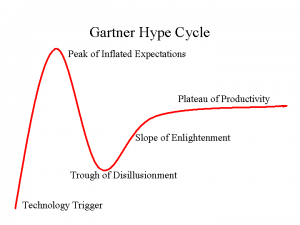It’s coming. But somehow it helps to know it’s coming.
There’s always the initial excitement, and the expansive vision of new possibilities. Then reality sets in.
The key is to recognize it’s part of the process: One does not reach the “plateau of productivity” without walking through the “trough of disillusionment.” The trough is where the idea is purified, distilled, crystallized — stripped of its misconceptions, to see what truly lays inside.
You do not reach the “plateau of productivity” without walking through the “trough of disillusionment.”
This is true of so many different scenarios.
As business owners, we might develop and launch a new product. In the process, we’ll be super excited about how it’s going to change things and help our customers. Then we’ll lose some of our enthusiasm because it’s taking longer than we thought to pull all the pieces together. Then we’ll get resistance from the market. Then we’ll start to question its validity. We’ve reached the trough of disillusionment.
What do you do when you reach the trough? How do you get through it? How do you know if it’s worth getting through? A few tried and tested suggestions: good friends, good mentors, remembering moving through past troughs, looking for and appreciating small buds of hope, re-examining and finding your convictions re-affirmed, and a good glass of wine. To be honest, sometimes the way out of the trough is not to see it through – the disillusionment allows us to see clearly that what we thought was there, isn’t. But the other times, we simply have to recognize we’re in the trough stage, allow the disillusionment to help us to focus on what’s truly important, and keep on moving through.
Taking our customers through change – they’re going to experience the trough too. Not over-promising, but making sure their expectations are realistic from the beginning is a good first step. (I strongly advise against moving ahead if you feel your customer may not have proper expectations, even if they’re willing to pay: it will only lead to a tough conversation later.) Letting the customer know the road will be bumpy, and the project will hit a trough inflection point at some part of the process, is also a good practice. And when you reach the trough, communicating to your customer that your professional experience in similar situations helps you guide them through to the other side.
If you’re moving to a different level, it helps to know the emotional path as much as the strategy path. Business is emotion, because business is human. Don’t be caught off guard by the trough for yourself or your customers – prepare for it, and ride it, through to new higher plateaus.
(As originally posted on the Thriveal blog.)

